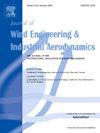Cladding pressure and load characteristics of a tall building under a simulated tornado-like vortex: An experimental study
IF 4.2
2区 工程技术
Q1 ENGINEERING, CIVIL
Journal of Wind Engineering and Industrial Aerodynamics
Pub Date : 2025-02-22
DOI:10.1016/j.jweia.2025.106059
引用次数: 0
Abstract
Tornadoes, characterized by their destructive wind forces and unpredictable nature, pose a significant threat to tall buildings. Understanding the cladding pressure distribution on tall buildings during tornado events is crucial for designing these structures that can withstand extreme forces. The present study provides a comprehensive analysis of the aerodynamic loads and cladding pressure characteristics of a tall building in a tornado by employing an aeroelastic model under a laboratory-simulated tornado at Iowa State University-Tornado Simulator (ISU-TS) facility. This study utilizes a 1:350 scale model of a tapered tall building with a circular cross-section to evaluate the dynamic loads and pressure distribution along the height and perimeter of the building during a stationary and translating tornado. Particular attention has been given to study the correlation of aerodynamic loads as a function of the radial distance from the tornado core, with the comparison of results between the stationary and translating tornado cases. The results indicate that peak aerodynamic loads on the tall building model occur once the tornado has passed the building's center. Correlation analysis shows that cross-correlation coefficient values of aerodynamic forces decrease more significantly with increasing radial distance from the tornado's core. Wavelet analysis results indicate that the critical time period, where peak aerodynamic forces occur, differs between the two directions, implying the building's vulnerability to peak loads is direction dependent.
模拟龙卷风涡旋作用下高层建筑覆层压力与荷载特性的实验研究
龙卷风的特点是具有破坏性的风力和不可预测的性质,对高层建筑构成重大威胁。了解高层建筑在龙卷风事件中的包层压力分布对于设计这些能够承受极端力量的结构至关重要。本研究在爱荷华州立大学龙卷风模拟器(ISU-TS)的实验室模拟龙卷风下,采用气动弹性模型对高层建筑在龙卷风中的气动载荷和包层压力特性进行了全面分析。本研究采用1:350比例的锥形高层建筑圆形截面模型来评估静止和转换龙卷风期间沿建筑物高度和周长的动载荷和压力分布。特别注意研究了气动载荷与龙卷风核心径向距离的关系,并比较了静止和移动龙卷风的结果。结果表明,当龙卷风经过建筑物中心时,高层建筑模型上的气动载荷出现峰值。相关分析表明,气动力的互相关系数值随着离龙卷风中心径向距离的增大而减小。小波分析结果表明,两个方向上出现气动力峰值的临界时段不同,表明建筑物对峰值荷载的脆弱性与方向有关。
本文章由计算机程序翻译,如有差异,请以英文原文为准。
求助全文
约1分钟内获得全文
求助全文
来源期刊
CiteScore
8.90
自引率
22.90%
发文量
306
审稿时长
4.4 months
期刊介绍:
The objective of the journal is to provide a means for the publication and interchange of information, on an international basis, on all those aspects of wind engineering that are included in the activities of the International Association for Wind Engineering http://www.iawe.org/. These are: social and economic impact of wind effects; wind characteristics and structure, local wind environments, wind loads and structural response, diffusion, pollutant dispersion and matter transport, wind effects on building heat loss and ventilation, wind effects on transport systems, aerodynamic aspects of wind energy generation, and codification of wind effects.
Papers on these subjects describing full-scale measurements, wind-tunnel simulation studies, computational or theoretical methods are published, as well as papers dealing with the development of techniques and apparatus for wind engineering experiments.

 求助内容:
求助内容: 应助结果提醒方式:
应助结果提醒方式:


